Importance of Corporate Reputation, Image, and Identity in Effective Communication
VerifiedAdded on 2023/04/21
|11
|2713
|79
AI Summary
This report explores the importance of corporate reputation, image, and identity in effective communication within organizations. It discusses the role of corporate brands and logos in shaping identity and the impact of barriers to communication on reputation. The report also provides recommendations to enhance communication strategies.
Contribute Materials
Your contribution can guide someone’s learning journey. Share your
documents today.
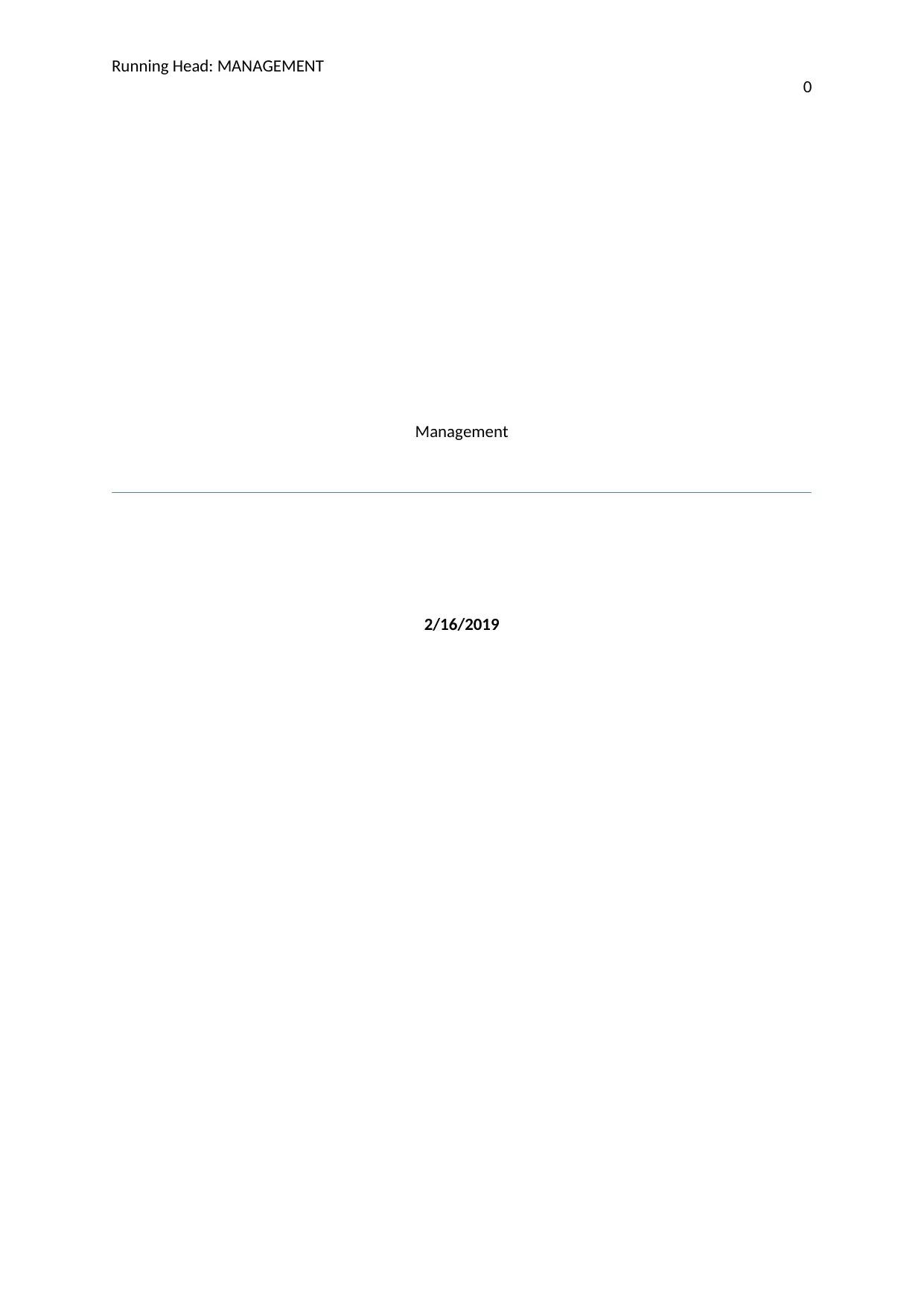
Running Head: MANAGEMENT
0
Management
2/16/2019
0
Management
2/16/2019
Secure Best Marks with AI Grader
Need help grading? Try our AI Grader for instant feedback on your assignments.
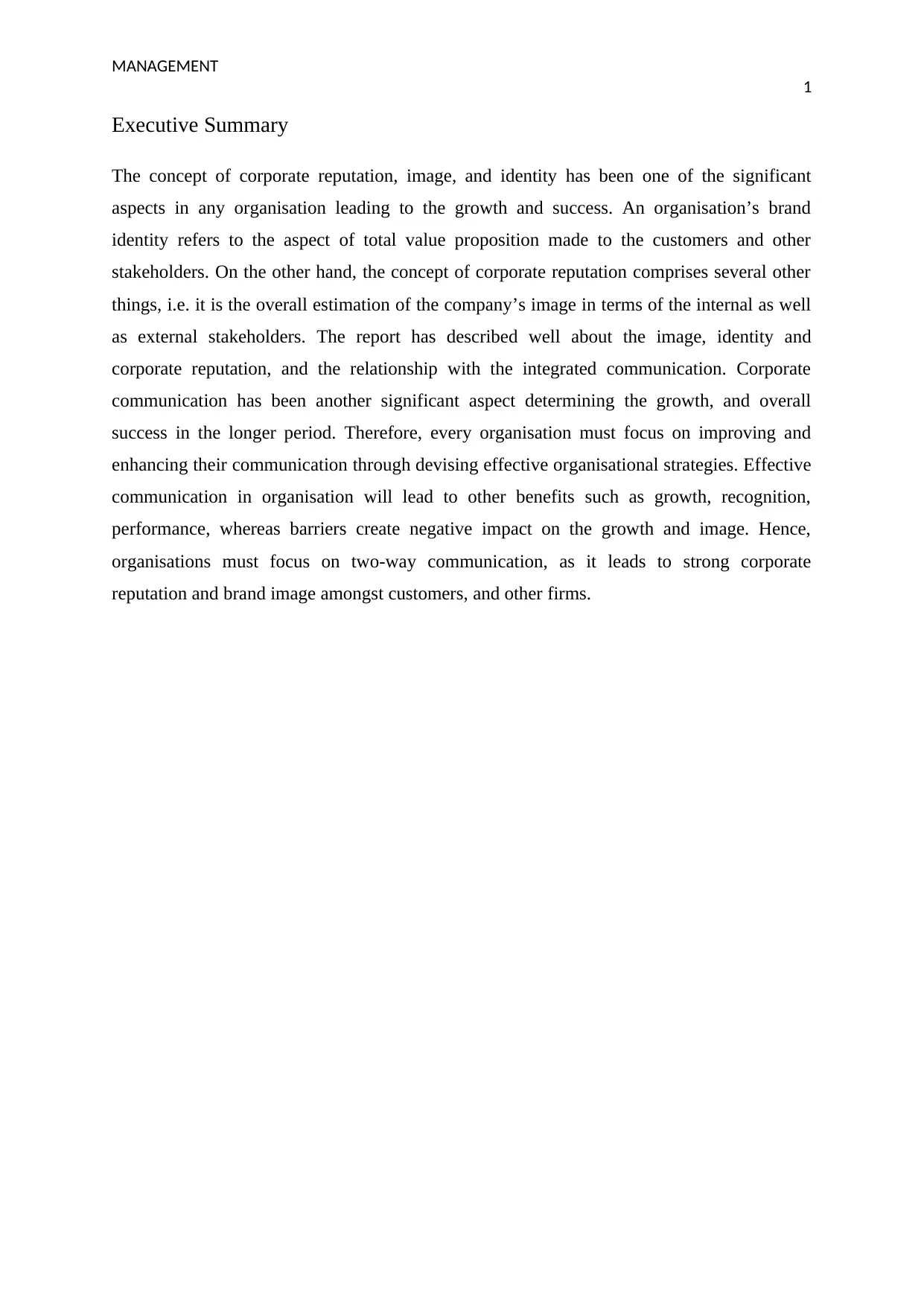
MANAGEMENT
1
Executive Summary
The concept of corporate reputation, image, and identity has been one of the significant
aspects in any organisation leading to the growth and success. An organisation’s brand
identity refers to the aspect of total value proposition made to the customers and other
stakeholders. On the other hand, the concept of corporate reputation comprises several other
things, i.e. it is the overall estimation of the company’s image in terms of the internal as well
as external stakeholders. The report has described well about the image, identity and
corporate reputation, and the relationship with the integrated communication. Corporate
communication has been another significant aspect determining the growth, and overall
success in the longer period. Therefore, every organisation must focus on improving and
enhancing their communication through devising effective organisational strategies. Effective
communication in organisation will lead to other benefits such as growth, recognition,
performance, whereas barriers create negative impact on the growth and image. Hence,
organisations must focus on two-way communication, as it leads to strong corporate
reputation and brand image amongst customers, and other firms.
1
Executive Summary
The concept of corporate reputation, image, and identity has been one of the significant
aspects in any organisation leading to the growth and success. An organisation’s brand
identity refers to the aspect of total value proposition made to the customers and other
stakeholders. On the other hand, the concept of corporate reputation comprises several other
things, i.e. it is the overall estimation of the company’s image in terms of the internal as well
as external stakeholders. The report has described well about the image, identity and
corporate reputation, and the relationship with the integrated communication. Corporate
communication has been another significant aspect determining the growth, and overall
success in the longer period. Therefore, every organisation must focus on improving and
enhancing their communication through devising effective organisational strategies. Effective
communication in organisation will lead to other benefits such as growth, recognition,
performance, whereas barriers create negative impact on the growth and image. Hence,
organisations must focus on two-way communication, as it leads to strong corporate
reputation and brand image amongst customers, and other firms.
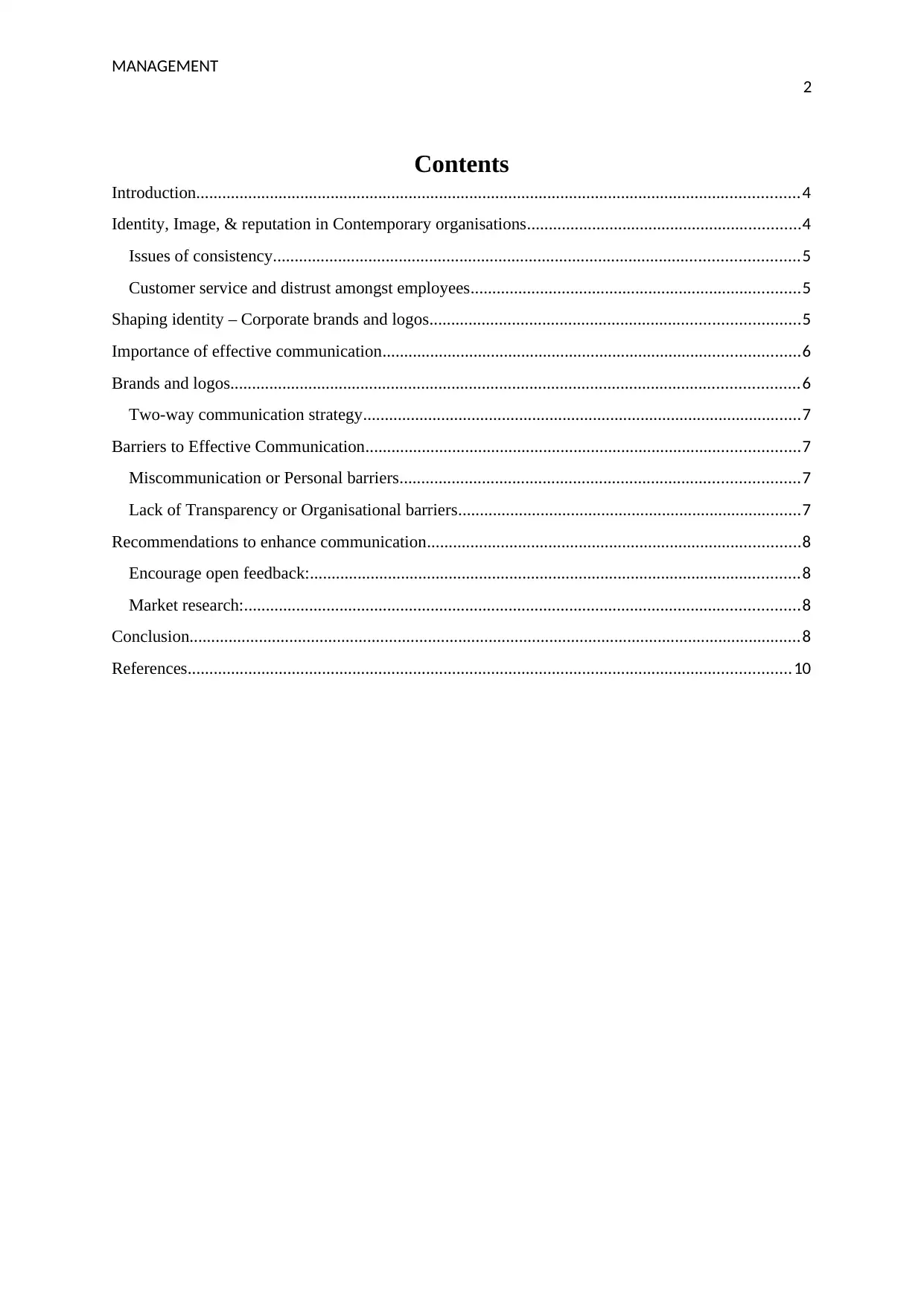
MANAGEMENT
2
Contents
Introduction...........................................................................................................................................4
Identity, Image, & reputation in Contemporary organisations...............................................................4
Issues of consistency.........................................................................................................................5
Customer service and distrust amongst employees............................................................................5
Shaping identity – Corporate brands and logos.....................................................................................5
Importance of effective communication................................................................................................6
Brands and logos...................................................................................................................................6
Two-way communication strategy.....................................................................................................7
Barriers to Effective Communication....................................................................................................7
Miscommunication or Personal barriers............................................................................................7
Lack of Transparency or Organisational barriers...............................................................................7
Recommendations to enhance communication......................................................................................8
Encourage open feedback:.................................................................................................................8
Market research:................................................................................................................................8
Conclusion.............................................................................................................................................8
References...........................................................................................................................................10
2
Contents
Introduction...........................................................................................................................................4
Identity, Image, & reputation in Contemporary organisations...............................................................4
Issues of consistency.........................................................................................................................5
Customer service and distrust amongst employees............................................................................5
Shaping identity – Corporate brands and logos.....................................................................................5
Importance of effective communication................................................................................................6
Brands and logos...................................................................................................................................6
Two-way communication strategy.....................................................................................................7
Barriers to Effective Communication....................................................................................................7
Miscommunication or Personal barriers............................................................................................7
Lack of Transparency or Organisational barriers...............................................................................7
Recommendations to enhance communication......................................................................................8
Encourage open feedback:.................................................................................................................8
Market research:................................................................................................................................8
Conclusion.............................................................................................................................................8
References...........................................................................................................................................10
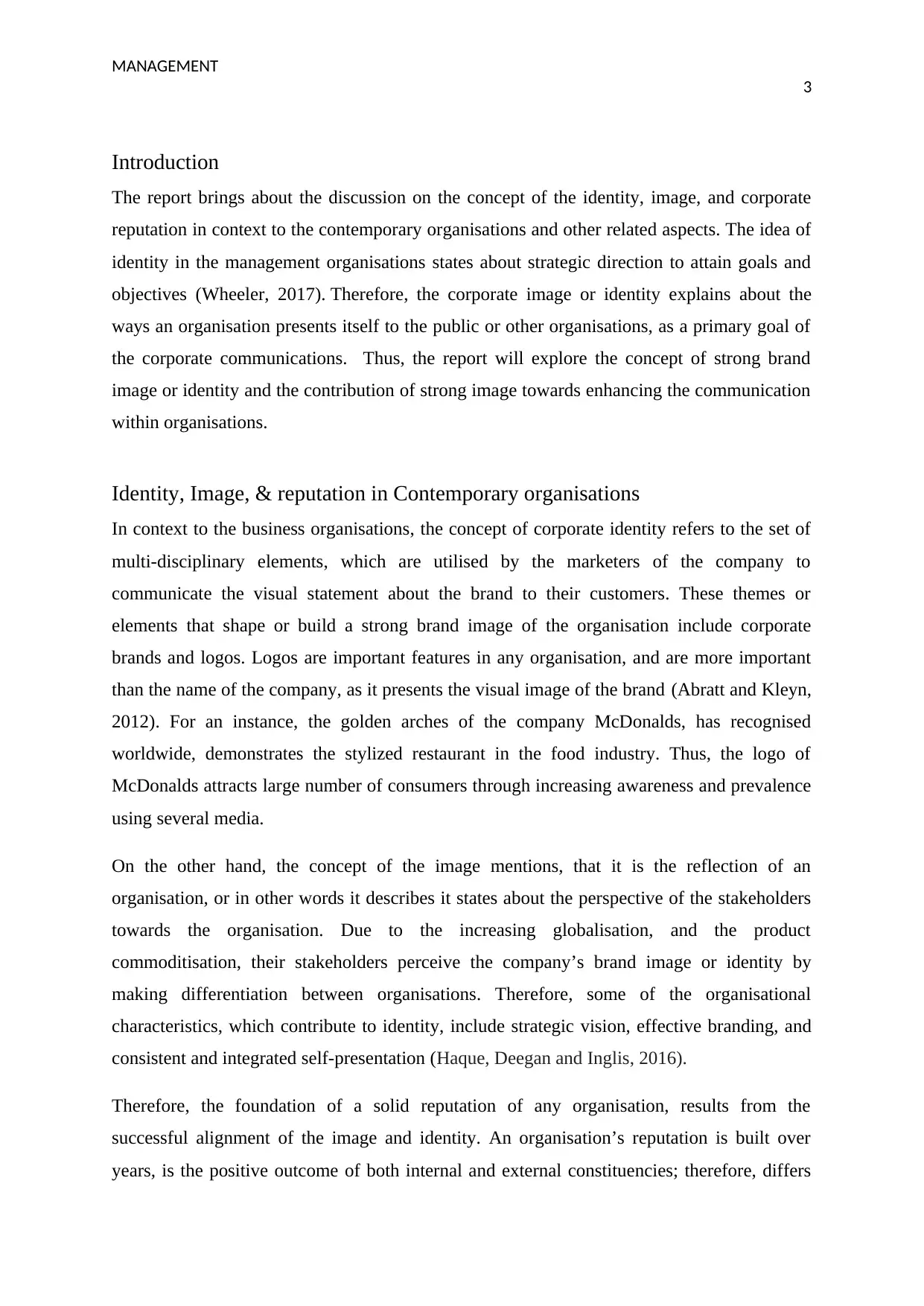
MANAGEMENT
3
Introduction
The report brings about the discussion on the concept of the identity, image, and corporate
reputation in context to the contemporary organisations and other related aspects. The idea of
identity in the management organisations states about strategic direction to attain goals and
objectives (Wheeler, 2017). Therefore, the corporate image or identity explains about the
ways an organisation presents itself to the public or other organisations, as a primary goal of
the corporate communications. Thus, the report will explore the concept of strong brand
image or identity and the contribution of strong image towards enhancing the communication
within organisations.
Identity, Image, & reputation in Contemporary organisations
In context to the business organisations, the concept of corporate identity refers to the set of
multi-disciplinary elements, which are utilised by the marketers of the company to
communicate the visual statement about the brand to their customers. These themes or
elements that shape or build a strong brand image of the organisation include corporate
brands and logos. Logos are important features in any organisation, and are more important
than the name of the company, as it presents the visual image of the brand (Abratt and Kleyn,
2012). For an instance, the golden arches of the company McDonalds, has recognised
worldwide, demonstrates the stylized restaurant in the food industry. Thus, the logo of
McDonalds attracts large number of consumers through increasing awareness and prevalence
using several media.
On the other hand, the concept of the image mentions, that it is the reflection of an
organisation, or in other words it describes it states about the perspective of the stakeholders
towards the organisation. Due to the increasing globalisation, and the product
commoditisation, their stakeholders perceive the company’s brand image or identity by
making differentiation between organisations. Therefore, some of the organisational
characteristics, which contribute to identity, include strategic vision, effective branding, and
consistent and integrated self-presentation (Haque, Deegan and Inglis, 2016).
Therefore, the foundation of a solid reputation of any organisation, results from the
successful alignment of the image and identity. An organisation’s reputation is built over
years, is the positive outcome of both internal and external constituencies; therefore, differs
3
Introduction
The report brings about the discussion on the concept of the identity, image, and corporate
reputation in context to the contemporary organisations and other related aspects. The idea of
identity in the management organisations states about strategic direction to attain goals and
objectives (Wheeler, 2017). Therefore, the corporate image or identity explains about the
ways an organisation presents itself to the public or other organisations, as a primary goal of
the corporate communications. Thus, the report will explore the concept of strong brand
image or identity and the contribution of strong image towards enhancing the communication
within organisations.
Identity, Image, & reputation in Contemporary organisations
In context to the business organisations, the concept of corporate identity refers to the set of
multi-disciplinary elements, which are utilised by the marketers of the company to
communicate the visual statement about the brand to their customers. These themes or
elements that shape or build a strong brand image of the organisation include corporate
brands and logos. Logos are important features in any organisation, and are more important
than the name of the company, as it presents the visual image of the brand (Abratt and Kleyn,
2012). For an instance, the golden arches of the company McDonalds, has recognised
worldwide, demonstrates the stylized restaurant in the food industry. Thus, the logo of
McDonalds attracts large number of consumers through increasing awareness and prevalence
using several media.
On the other hand, the concept of the image mentions, that it is the reflection of an
organisation, or in other words it describes it states about the perspective of the stakeholders
towards the organisation. Due to the increasing globalisation, and the product
commoditisation, their stakeholders perceive the company’s brand image or identity by
making differentiation between organisations. Therefore, some of the organisational
characteristics, which contribute to identity, include strategic vision, effective branding, and
consistent and integrated self-presentation (Haque, Deegan and Inglis, 2016).
Therefore, the foundation of a solid reputation of any organisation, results from the
successful alignment of the image and identity. An organisation’s reputation is built over
years, is the positive outcome of both internal and external constituencies; therefore, differs
Secure Best Marks with AI Grader
Need help grading? Try our AI Grader for instant feedback on your assignments.
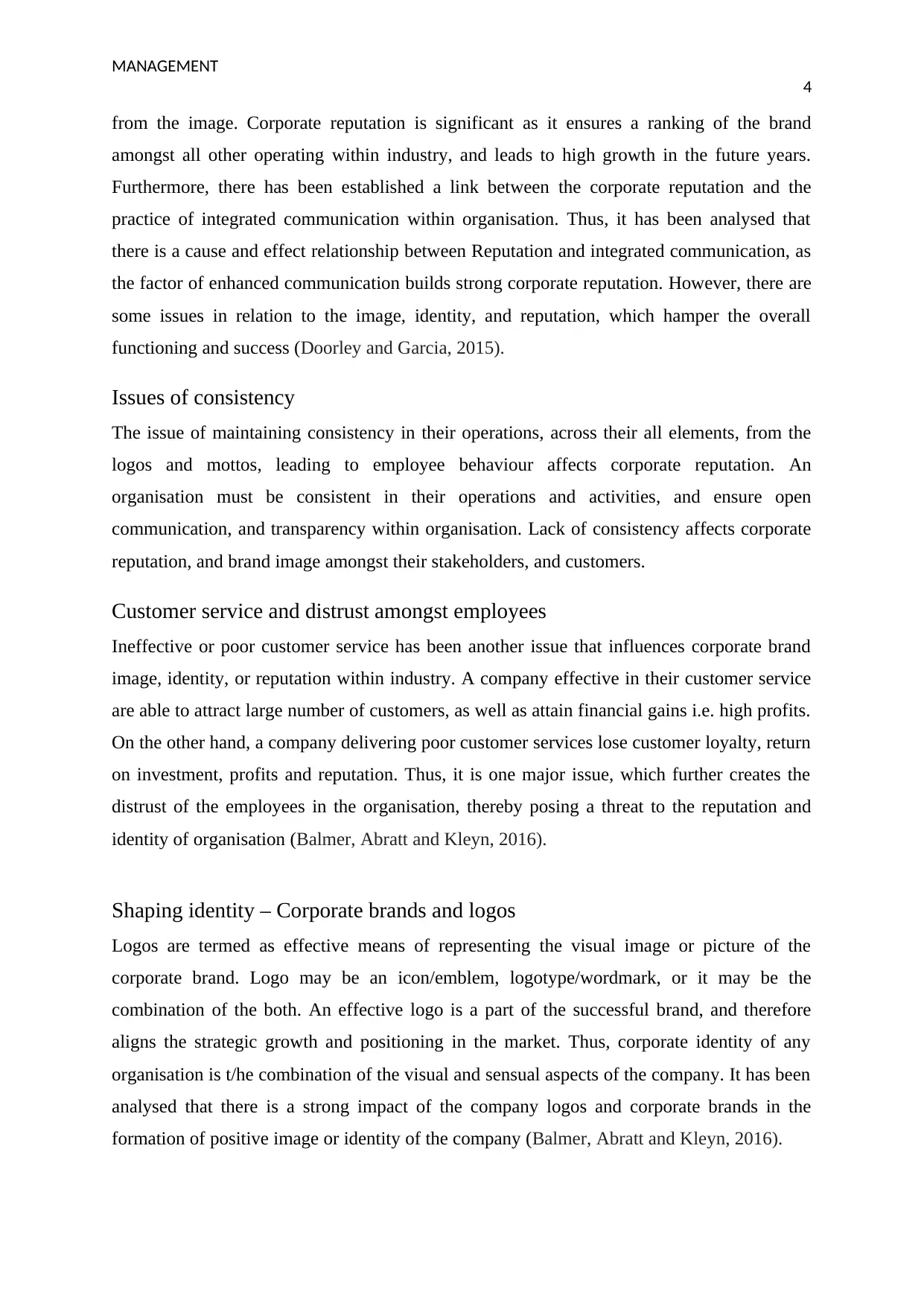
MANAGEMENT
4
from the image. Corporate reputation is significant as it ensures a ranking of the brand
amongst all other operating within industry, and leads to high growth in the future years.
Furthermore, there has been established a link between the corporate reputation and the
practice of integrated communication within organisation. Thus, it has been analysed that
there is a cause and effect relationship between Reputation and integrated communication, as
the factor of enhanced communication builds strong corporate reputation. However, there are
some issues in relation to the image, identity, and reputation, which hamper the overall
functioning and success (Doorley and Garcia, 2015).
Issues of consistency
The issue of maintaining consistency in their operations, across their all elements, from the
logos and mottos, leading to employee behaviour affects corporate reputation. An
organisation must be consistent in their operations and activities, and ensure open
communication, and transparency within organisation. Lack of consistency affects corporate
reputation, and brand image amongst their stakeholders, and customers.
Customer service and distrust amongst employees
Ineffective or poor customer service has been another issue that influences corporate brand
image, identity, or reputation within industry. A company effective in their customer service
are able to attract large number of customers, as well as attain financial gains i.e. high profits.
On the other hand, a company delivering poor customer services lose customer loyalty, return
on investment, profits and reputation. Thus, it is one major issue, which further creates the
distrust of the employees in the organisation, thereby posing a threat to the reputation and
identity of organisation (Balmer, Abratt and Kleyn, 2016).
Shaping identity – Corporate brands and logos
Logos are termed as effective means of representing the visual image or picture of the
corporate brand. Logo may be an icon/emblem, logotype/wordmark, or it may be the
combination of the both. An effective logo is a part of the successful brand, and therefore
aligns the strategic growth and positioning in the market. Thus, corporate identity of any
organisation is t/he combination of the visual and sensual aspects of the company. It has been
analysed that there is a strong impact of the company logos and corporate brands in the
formation of positive image or identity of the company (Balmer, Abratt and Kleyn, 2016).
4
from the image. Corporate reputation is significant as it ensures a ranking of the brand
amongst all other operating within industry, and leads to high growth in the future years.
Furthermore, there has been established a link between the corporate reputation and the
practice of integrated communication within organisation. Thus, it has been analysed that
there is a cause and effect relationship between Reputation and integrated communication, as
the factor of enhanced communication builds strong corporate reputation. However, there are
some issues in relation to the image, identity, and reputation, which hamper the overall
functioning and success (Doorley and Garcia, 2015).
Issues of consistency
The issue of maintaining consistency in their operations, across their all elements, from the
logos and mottos, leading to employee behaviour affects corporate reputation. An
organisation must be consistent in their operations and activities, and ensure open
communication, and transparency within organisation. Lack of consistency affects corporate
reputation, and brand image amongst their stakeholders, and customers.
Customer service and distrust amongst employees
Ineffective or poor customer service has been another issue that influences corporate brand
image, identity, or reputation within industry. A company effective in their customer service
are able to attract large number of customers, as well as attain financial gains i.e. high profits.
On the other hand, a company delivering poor customer services lose customer loyalty, return
on investment, profits and reputation. Thus, it is one major issue, which further creates the
distrust of the employees in the organisation, thereby posing a threat to the reputation and
identity of organisation (Balmer, Abratt and Kleyn, 2016).
Shaping identity – Corporate brands and logos
Logos are termed as effective means of representing the visual image or picture of the
corporate brand. Logo may be an icon/emblem, logotype/wordmark, or it may be the
combination of the both. An effective logo is a part of the successful brand, and therefore
aligns the strategic growth and positioning in the market. Thus, corporate identity of any
organisation is t/he combination of the visual and sensual aspects of the company. It has been
analysed that there is a strong impact of the company logos and corporate brands in the
formation of positive image or identity of the company (Balmer, Abratt and Kleyn, 2016).
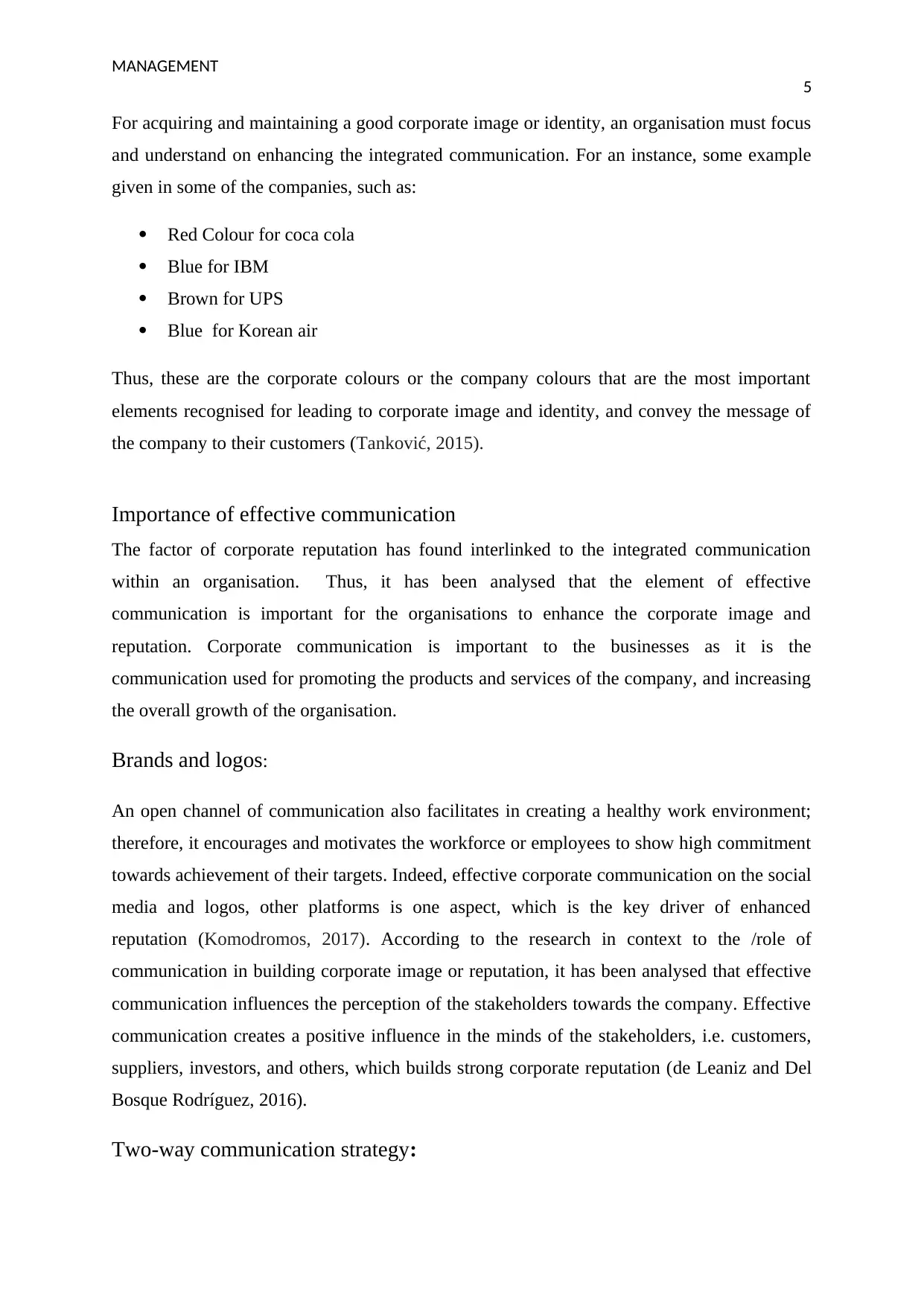
MANAGEMENT
5
For acquiring and maintaining a good corporate image or identity, an organisation must focus
and understand on enhancing the integrated communication. For an instance, some example
given in some of the companies, such as:
Red Colour for coca cola
Blue for IBM
Brown for UPS
Blue for Korean air
Thus, these are the corporate colours or the company colours that are the most important
elements recognised for leading to corporate image and identity, and convey the message of
the company to their customers (Tanković, 2015).
Importance of effective communication
The factor of corporate reputation has found interlinked to the integrated communication
within an organisation. Thus, it has been analysed that the element of effective
communication is important for the organisations to enhance the corporate image and
reputation. Corporate communication is important to the businesses as it is the
communication used for promoting the products and services of the company, and increasing
the overall growth of the organisation.
Brands and logos:
An open channel of communication also facilitates in creating a healthy work environment;
therefore, it encourages and motivates the workforce or employees to show high commitment
towards achievement of their targets. Indeed, effective corporate communication on the social
media and logos, other platforms is one aspect, which is the key driver of enhanced
reputation (Komodromos, 2017). According to the research in context to the /role of
communication in building corporate image or reputation, it has been analysed that effective
communication influences the perception of the stakeholders towards the company. Effective
communication creates a positive influence in the minds of the stakeholders, i.e. customers,
suppliers, investors, and others, which builds strong corporate reputation (de Leaniz and Del
Bosque Rodríguez, 2016).
Two-way communication strategy:
5
For acquiring and maintaining a good corporate image or identity, an organisation must focus
and understand on enhancing the integrated communication. For an instance, some example
given in some of the companies, such as:
Red Colour for coca cola
Blue for IBM
Brown for UPS
Blue for Korean air
Thus, these are the corporate colours or the company colours that are the most important
elements recognised for leading to corporate image and identity, and convey the message of
the company to their customers (Tanković, 2015).
Importance of effective communication
The factor of corporate reputation has found interlinked to the integrated communication
within an organisation. Thus, it has been analysed that the element of effective
communication is important for the organisations to enhance the corporate image and
reputation. Corporate communication is important to the businesses as it is the
communication used for promoting the products and services of the company, and increasing
the overall growth of the organisation.
Brands and logos:
An open channel of communication also facilitates in creating a healthy work environment;
therefore, it encourages and motivates the workforce or employees to show high commitment
towards achievement of their targets. Indeed, effective corporate communication on the social
media and logos, other platforms is one aspect, which is the key driver of enhanced
reputation (Komodromos, 2017). According to the research in context to the /role of
communication in building corporate image or reputation, it has been analysed that effective
communication influences the perception of the stakeholders towards the company. Effective
communication creates a positive influence in the minds of the stakeholders, i.e. customers,
suppliers, investors, and others, which builds strong corporate reputation (de Leaniz and Del
Bosque Rodríguez, 2016).
Two-way communication strategy:
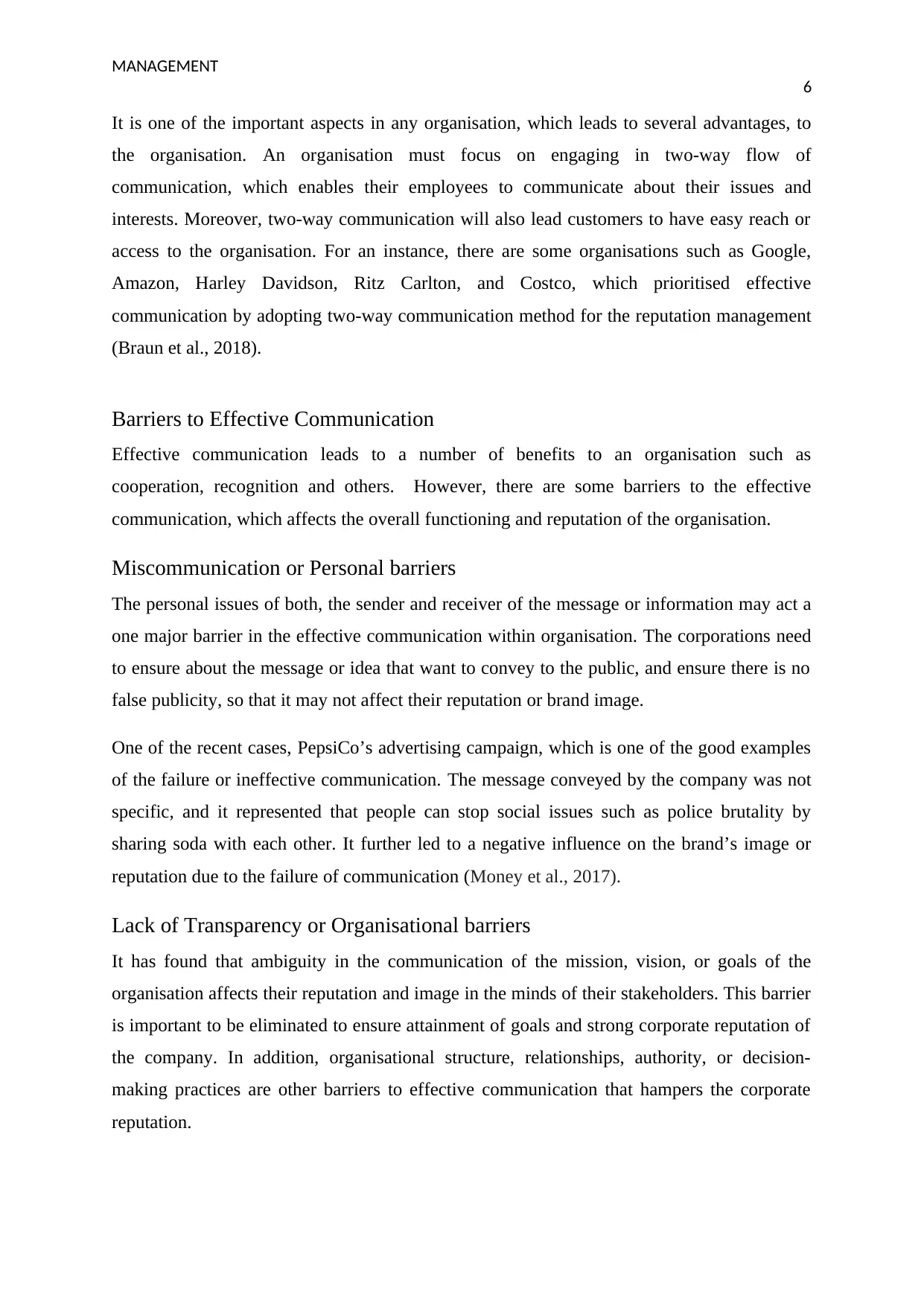
MANAGEMENT
6
It is one of the important aspects in any organisation, which leads to several advantages, to
the organisation. An organisation must focus on engaging in two-way flow of
communication, which enables their employees to communicate about their issues and
interests. Moreover, two-way communication will also lead customers to have easy reach or
access to the organisation. For an instance, there are some organisations such as Google,
Amazon, Harley Davidson, Ritz Carlton, and Costco, which prioritised effective
communication by adopting two-way communication method for the reputation management
(Braun et al., 2018).
Barriers to Effective Communication
Effective communication leads to a number of benefits to an organisation such as
cooperation, recognition and others. However, there are some barriers to the effective
communication, which affects the overall functioning and reputation of the organisation.
Miscommunication or Personal barriers
The personal issues of both, the sender and receiver of the message or information may act a
one major barrier in the effective communication within organisation. The corporations need
to ensure about the message or idea that want to convey to the public, and ensure there is no
false publicity, so that it may not affect their reputation or brand image.
One of the recent cases, PepsiCo’s advertising campaign, which is one of the good examples
of the failure or ineffective communication. The message conveyed by the company was not
specific, and it represented that people can stop social issues such as police brutality by
sharing soda with each other. It further led to a negative influence on the brand’s image or
reputation due to the failure of communication (Money et al., 2017).
Lack of Transparency or Organisational barriers
It has found that ambiguity in the communication of the mission, vision, or goals of the
organisation affects their reputation and image in the minds of their stakeholders. This barrier
is important to be eliminated to ensure attainment of goals and strong corporate reputation of
the company. In addition, organisational structure, relationships, authority, or decision-
making practices are other barriers to effective communication that hampers the corporate
reputation.
6
It is one of the important aspects in any organisation, which leads to several advantages, to
the organisation. An organisation must focus on engaging in two-way flow of
communication, which enables their employees to communicate about their issues and
interests. Moreover, two-way communication will also lead customers to have easy reach or
access to the organisation. For an instance, there are some organisations such as Google,
Amazon, Harley Davidson, Ritz Carlton, and Costco, which prioritised effective
communication by adopting two-way communication method for the reputation management
(Braun et al., 2018).
Barriers to Effective Communication
Effective communication leads to a number of benefits to an organisation such as
cooperation, recognition and others. However, there are some barriers to the effective
communication, which affects the overall functioning and reputation of the organisation.
Miscommunication or Personal barriers
The personal issues of both, the sender and receiver of the message or information may act a
one major barrier in the effective communication within organisation. The corporations need
to ensure about the message or idea that want to convey to the public, and ensure there is no
false publicity, so that it may not affect their reputation or brand image.
One of the recent cases, PepsiCo’s advertising campaign, which is one of the good examples
of the failure or ineffective communication. The message conveyed by the company was not
specific, and it represented that people can stop social issues such as police brutality by
sharing soda with each other. It further led to a negative influence on the brand’s image or
reputation due to the failure of communication (Money et al., 2017).
Lack of Transparency or Organisational barriers
It has found that ambiguity in the communication of the mission, vision, or goals of the
organisation affects their reputation and image in the minds of their stakeholders. This barrier
is important to be eliminated to ensure attainment of goals and strong corporate reputation of
the company. In addition, organisational structure, relationships, authority, or decision-
making practices are other barriers to effective communication that hampers the corporate
reputation.
Paraphrase This Document
Need a fresh take? Get an instant paraphrase of this document with our AI Paraphraser
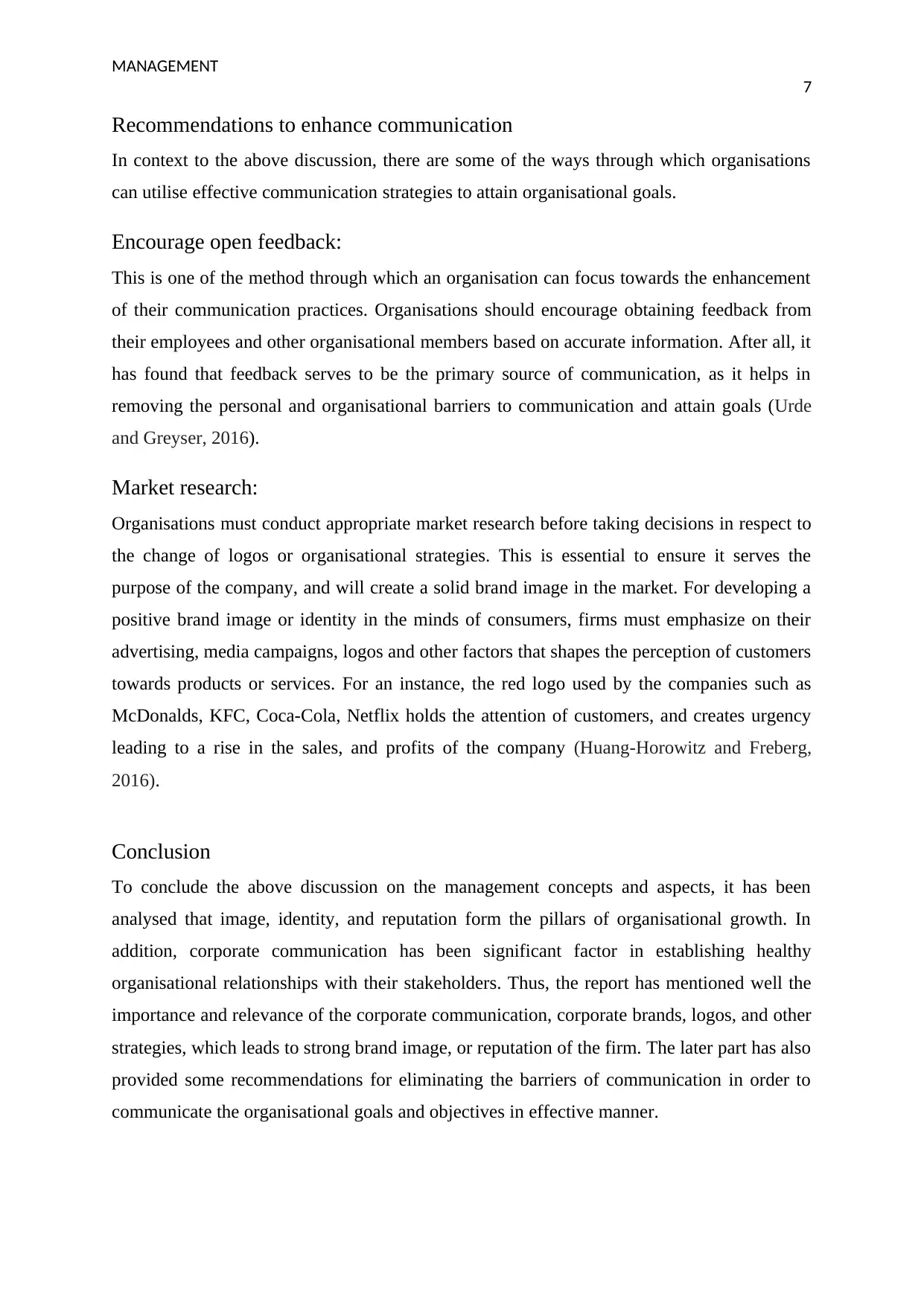
MANAGEMENT
7
Recommendations to enhance communication
In context to the above discussion, there are some of the ways through which organisations
can utilise effective communication strategies to attain organisational goals.
Encourage open feedback:
This is one of the method through which an organisation can focus towards the enhancement
of their communication practices. Organisations should encourage obtaining feedback from
their employees and other organisational members based on accurate information. After all, it
has found that feedback serves to be the primary source of communication, as it helps in
removing the personal and organisational barriers to communication and attain goals (Urde
and Greyser, 2016).
Market research:
Organisations must conduct appropriate market research before taking decisions in respect to
the change of logos or organisational strategies. This is essential to ensure it serves the
purpose of the company, and will create a solid brand image in the market. For developing a
positive brand image or identity in the minds of consumers, firms must emphasize on their
advertising, media campaigns, logos and other factors that shapes the perception of customers
towards products or services. For an instance, the red logo used by the companies such as
McDonalds, KFC, Coca-Cola, Netflix holds the attention of customers, and creates urgency
leading to a rise in the sales, and profits of the company (Huang-Horowitz and Freberg,
2016).
Conclusion
To conclude the above discussion on the management concepts and aspects, it has been
analysed that image, identity, and reputation form the pillars of organisational growth. In
addition, corporate communication has been significant factor in establishing healthy
organisational relationships with their stakeholders. Thus, the report has mentioned well the
importance and relevance of the corporate communication, corporate brands, logos, and other
strategies, which leads to strong brand image, or reputation of the firm. The later part has also
provided some recommendations for eliminating the barriers of communication in order to
communicate the organisational goals and objectives in effective manner.
7
Recommendations to enhance communication
In context to the above discussion, there are some of the ways through which organisations
can utilise effective communication strategies to attain organisational goals.
Encourage open feedback:
This is one of the method through which an organisation can focus towards the enhancement
of their communication practices. Organisations should encourage obtaining feedback from
their employees and other organisational members based on accurate information. After all, it
has found that feedback serves to be the primary source of communication, as it helps in
removing the personal and organisational barriers to communication and attain goals (Urde
and Greyser, 2016).
Market research:
Organisations must conduct appropriate market research before taking decisions in respect to
the change of logos or organisational strategies. This is essential to ensure it serves the
purpose of the company, and will create a solid brand image in the market. For developing a
positive brand image or identity in the minds of consumers, firms must emphasize on their
advertising, media campaigns, logos and other factors that shapes the perception of customers
towards products or services. For an instance, the red logo used by the companies such as
McDonalds, KFC, Coca-Cola, Netflix holds the attention of customers, and creates urgency
leading to a rise in the sales, and profits of the company (Huang-Horowitz and Freberg,
2016).
Conclusion
To conclude the above discussion on the management concepts and aspects, it has been
analysed that image, identity, and reputation form the pillars of organisational growth. In
addition, corporate communication has been significant factor in establishing healthy
organisational relationships with their stakeholders. Thus, the report has mentioned well the
importance and relevance of the corporate communication, corporate brands, logos, and other
strategies, which leads to strong brand image, or reputation of the firm. The later part has also
provided some recommendations for eliminating the barriers of communication in order to
communicate the organisational goals and objectives in effective manner.

MANAGEMENT
8
8
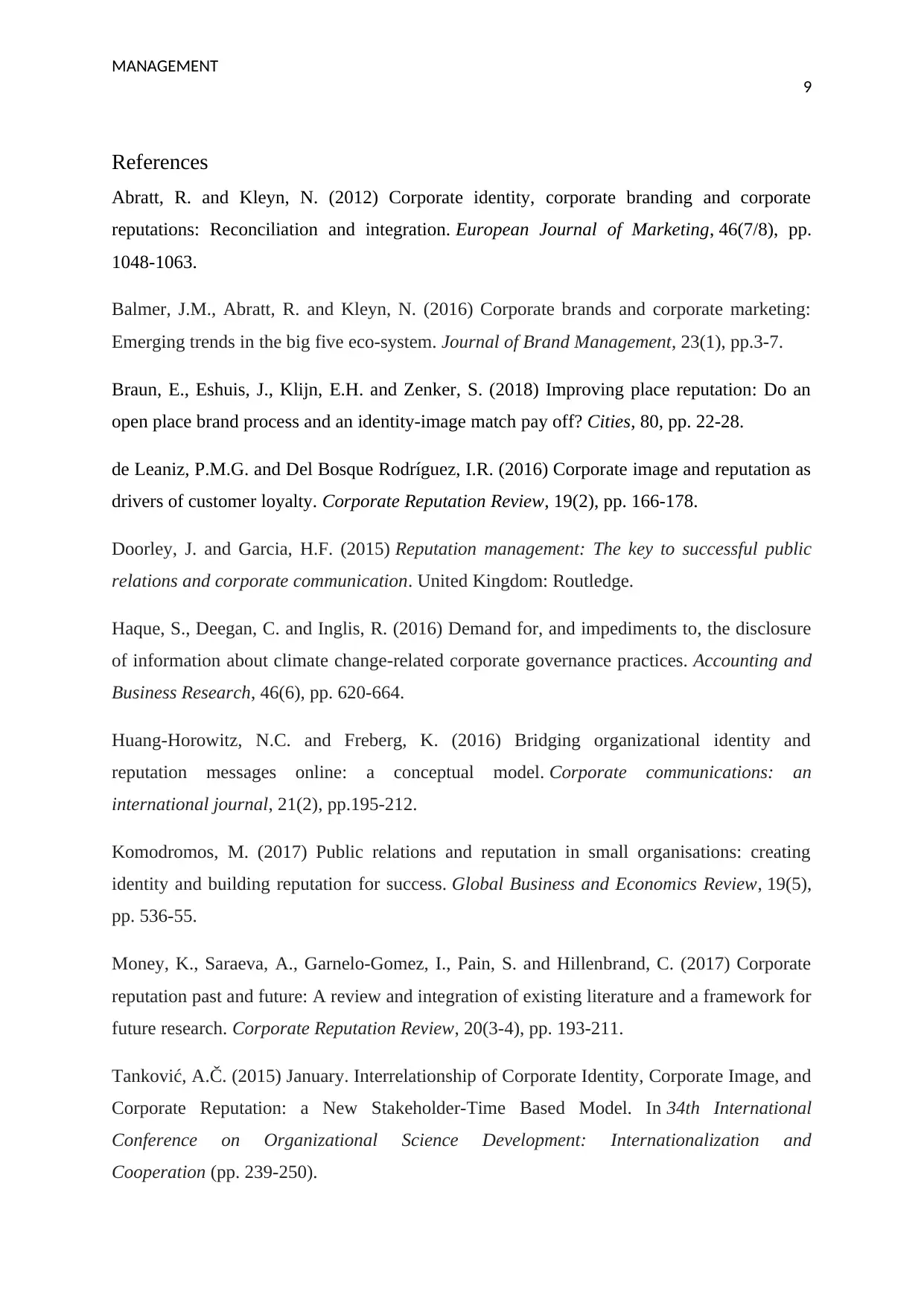
MANAGEMENT
9
References
Abratt, R. and Kleyn, N. (2012) Corporate identity, corporate branding and corporate
reputations: Reconciliation and integration. European Journal of Marketing, 46(7/8), pp.
1048-1063.
Balmer, J.M., Abratt, R. and Kleyn, N. (2016) Corporate brands and corporate marketing:
Emerging trends in the big five eco-system. Journal of Brand Management, 23(1), pp.3-7.
Braun, E., Eshuis, J., Klijn, E.H. and Zenker, S. (2018) Improving place reputation: Do an
open place brand process and an identity-image match pay off? Cities, 80, pp. 22-28.
de Leaniz, P.M.G. and Del Bosque Rodríguez, I.R. (2016) Corporate image and reputation as
drivers of customer loyalty. Corporate Reputation Review, 19(2), pp. 166-178.
Doorley, J. and Garcia, H.F. (2015) Reputation management: The key to successful public
relations and corporate communication. United Kingdom: Routledge.
Haque, S., Deegan, C. and Inglis, R. (2016) Demand for, and impediments to, the disclosure
of information about climate change-related corporate governance practices. Accounting and
Business Research, 46(6), pp. 620-664.
Huang-Horowitz, N.C. and Freberg, K. (2016) Bridging organizational identity and
reputation messages online: a conceptual model. Corporate communications: an
international journal, 21(2), pp.195-212.
Komodromos, M. (2017) Public relations and reputation in small organisations: creating
identity and building reputation for success. Global Business and Economics Review, 19(5),
pp. 536-55.
Money, K., Saraeva, A., Garnelo-Gomez, I., Pain, S. and Hillenbrand, C. (2017) Corporate
reputation past and future: A review and integration of existing literature and a framework for
future research. Corporate Reputation Review, 20(3-4), pp. 193-211.
Tanković, A.Č. (2015) January. Interrelationship of Corporate Identity, Corporate Image, and
Corporate Reputation: a New Stakeholder-Time Based Model. In 34th International
Conference on Organizational Science Development: Internationalization and
Cooperation (pp. 239-250).
9
References
Abratt, R. and Kleyn, N. (2012) Corporate identity, corporate branding and corporate
reputations: Reconciliation and integration. European Journal of Marketing, 46(7/8), pp.
1048-1063.
Balmer, J.M., Abratt, R. and Kleyn, N. (2016) Corporate brands and corporate marketing:
Emerging trends in the big five eco-system. Journal of Brand Management, 23(1), pp.3-7.
Braun, E., Eshuis, J., Klijn, E.H. and Zenker, S. (2018) Improving place reputation: Do an
open place brand process and an identity-image match pay off? Cities, 80, pp. 22-28.
de Leaniz, P.M.G. and Del Bosque Rodríguez, I.R. (2016) Corporate image and reputation as
drivers of customer loyalty. Corporate Reputation Review, 19(2), pp. 166-178.
Doorley, J. and Garcia, H.F. (2015) Reputation management: The key to successful public
relations and corporate communication. United Kingdom: Routledge.
Haque, S., Deegan, C. and Inglis, R. (2016) Demand for, and impediments to, the disclosure
of information about climate change-related corporate governance practices. Accounting and
Business Research, 46(6), pp. 620-664.
Huang-Horowitz, N.C. and Freberg, K. (2016) Bridging organizational identity and
reputation messages online: a conceptual model. Corporate communications: an
international journal, 21(2), pp.195-212.
Komodromos, M. (2017) Public relations and reputation in small organisations: creating
identity and building reputation for success. Global Business and Economics Review, 19(5),
pp. 536-55.
Money, K., Saraeva, A., Garnelo-Gomez, I., Pain, S. and Hillenbrand, C. (2017) Corporate
reputation past and future: A review and integration of existing literature and a framework for
future research. Corporate Reputation Review, 20(3-4), pp. 193-211.
Tanković, A.Č. (2015) January. Interrelationship of Corporate Identity, Corporate Image, and
Corporate Reputation: a New Stakeholder-Time Based Model. In 34th International
Conference on Organizational Science Development: Internationalization and
Cooperation (pp. 239-250).
Secure Best Marks with AI Grader
Need help grading? Try our AI Grader for instant feedback on your assignments.
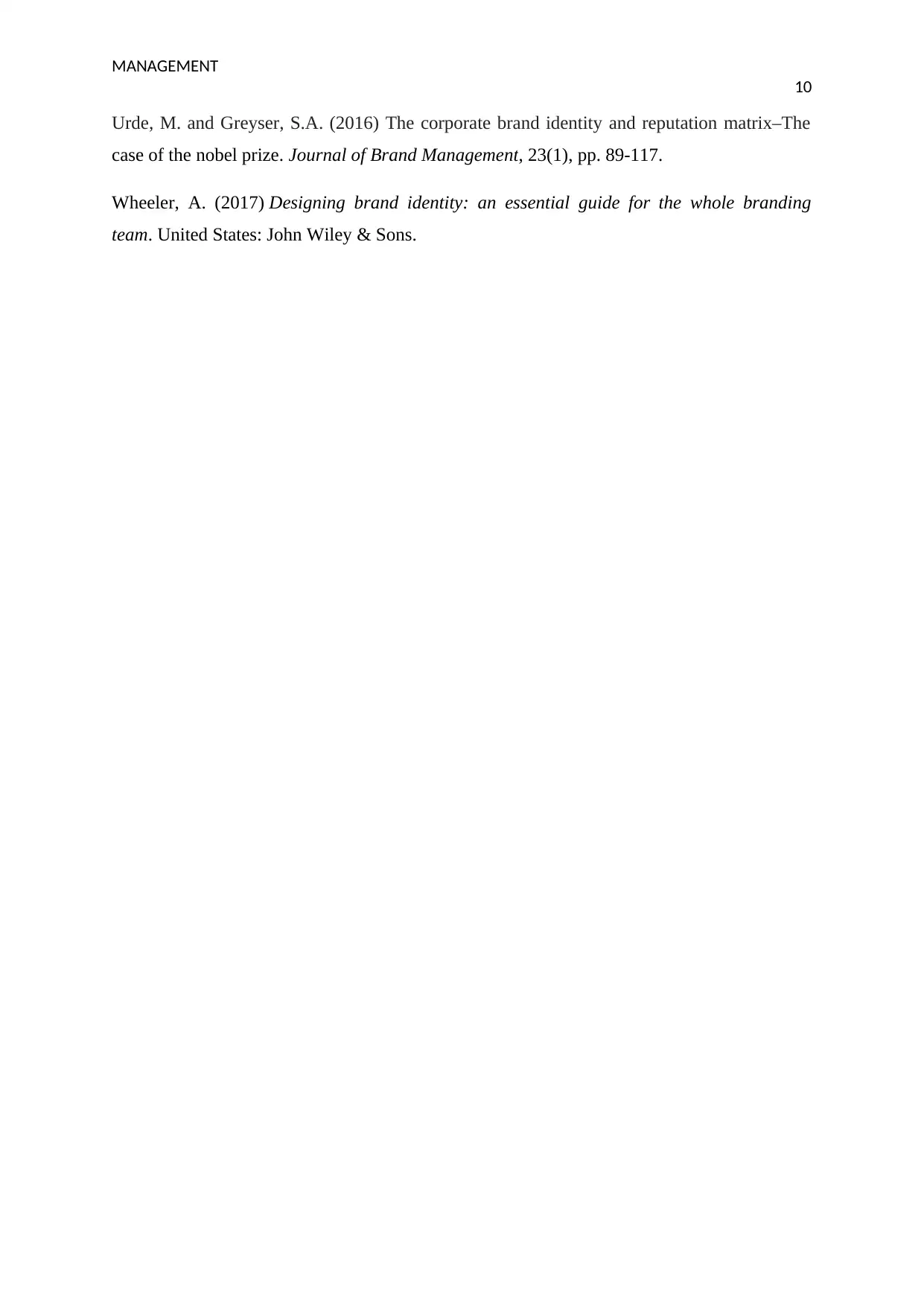
MANAGEMENT
10
Urde, M. and Greyser, S.A. (2016) The corporate brand identity and reputation matrix–The
case of the nobel prize. Journal of Brand Management, 23(1), pp. 89-117.
Wheeler, A. (2017) Designing brand identity: an essential guide for the whole branding
team. United States: John Wiley & Sons.
10
Urde, M. and Greyser, S.A. (2016) The corporate brand identity and reputation matrix–The
case of the nobel prize. Journal of Brand Management, 23(1), pp. 89-117.
Wheeler, A. (2017) Designing brand identity: an essential guide for the whole branding
team. United States: John Wiley & Sons.
1 out of 11
Related Documents
Your All-in-One AI-Powered Toolkit for Academic Success.
+13062052269
info@desklib.com
Available 24*7 on WhatsApp / Email
![[object Object]](/_next/static/media/star-bottom.7253800d.svg)
Unlock your academic potential
© 2024 | Zucol Services PVT LTD | All rights reserved.





